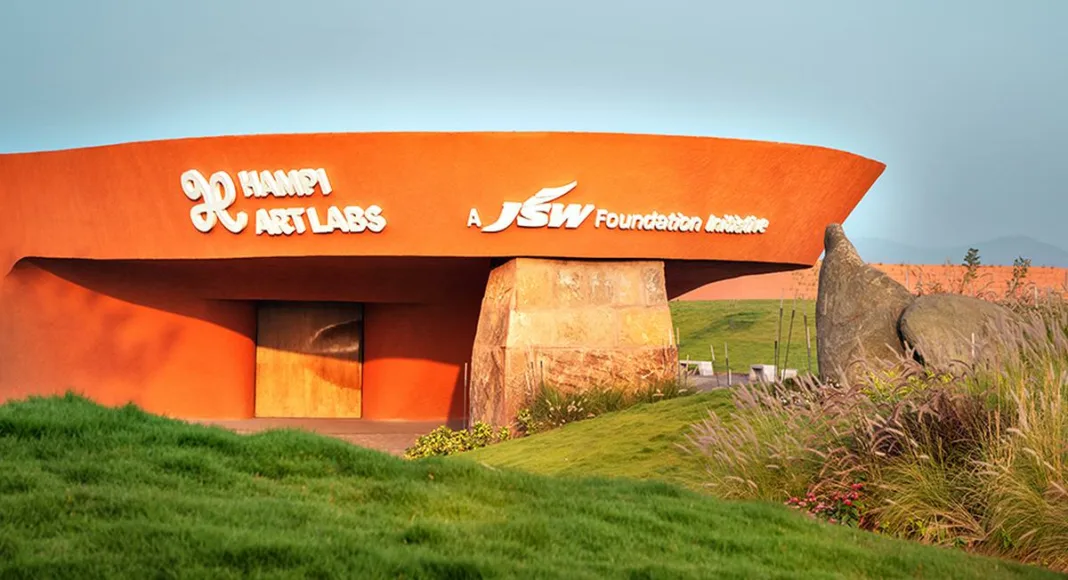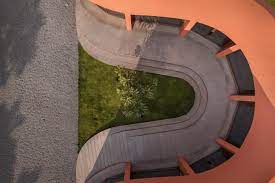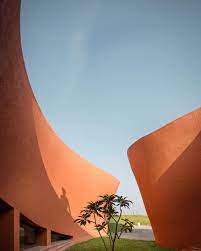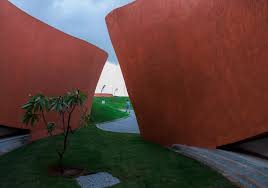The contemporary demand for architecture to honour heritage and nature is experiencing a significant upsurge, indicating a societal shift toward a more holistic and sustainable design approach. Communities now seek structures that not only encompass modern functionalities but also pay tribute to the rich cultural legacy of their surroundings. This increasing emphasis on contextual sensitivity goes beyond geographical boundaries, with architects globally acknowledging the importance of preserving cultural heritage and coexisting with nature.
Projects like Hampi Art Labs exemplify this trend by mirroring the contours of the Tungabhadra River and utilising locally sourced terracotta. Such endeavours showcase a harmonious integration of heritage and nature.
About Hampi Art Labs
Founded by Sangita Jindal and Tarini Jindal Handa, Hampi Art Labs is an initiative of the JSW Foundation, seamlessly blending art, heritage, and nature.
Positioned adjacent to the UNESCO World Heritage Site of Hampi, India, the Hampi Art Labs designed by Sameep Padora, the founder and principal of sP+A architectural practice, opened on 6th February 2024. Spanning an expansive 18-acre area, this art centre offers artists various production facilities, spaces for creative work, and galleries for displaying art, including exhibition spaces, studios, residency apartments, gardens, and a café. Its facilities also cater to various artistic workshops such as printmaking, sculpture in stone and metal, ceramics, and new media, fostering a connection between artists and the region’s rich craft traditions.

Hampi Art Labs serves as a multifunctional creative space that includes exhibition areas, studios, ceramic and printmaking workshops, vibrant gardens, residency apartments, and a charming café. The deliberate curation of spaces emphasises a holistic approach to artistic expression, fostering an environment where creativity can flourish.
Embracing Art, Heritage, and Nature For Design of Hampi Art Labs
Sameep Padora, the visionary founder and principal of his Mumbai-based practice, approached the creation of Hampi Art Labs with a profound sense of responsibility, considering the rich history of the site. The city of Hampi, known today for its cultural significance, was once the vibrant capital of the Vijayanagara Empire between the 14th and early 17th centuries. This era witnessed the construction of forts, royal complexes, temples, pillared concourses, memorial structures, and waterways—a testament to an architectural legacy that endured beyond the empire’s reign. Despite facing invasions that left many structures beyond redemption, certain architectural marvels persevered. Today, they stand alongside the rugged hills and naturally occurring granite boulders that define Hampi’s distinctive landscape.
As Sameep Padora Associates embarked on the creation of Hampi Art Labs, their architectural endeavour resonates with the grandeur of Vijayanagar’s historical epoch. The design intricacies reflect a meticulous study of the kingdom’s architectural marvels and the cultural affluence that defined an era of artistic renaissance. Pandora grappled with a pivotal decision—to draw inspiration from the historic architecture or the barren landscape. Ultimately, he chose the latter, emphasising the importance of contextualising the new build with what had endured over the centuries. The architecture sought to integrate seamlessly with the resilient elements of the site rather than imposing a foreign presence.

Sangita Jindal’s Affinity for Hampi: A Personal Connection
Sangita Jindal, chairperson of the JSW Foundation,reflecting on her deep bond with Hampi dating back to her first visit in 1983, expresses delight in connecting contemporary art with the rich tapestry of heritage and nature. Additionally, she draws inspiration from her mother, Urmila Kanoria, the founder of one of India’s earliest residency programs at the Kanoria Centre for Arts in Ahmedabad in 1984.
Collaborative Vision: Tarini Jindal Handa’s Perspective
Tarini Jindal Handa, Managing Director of JSW Realty, emphasises the collaborative spirit that fuels the essence of Hampi Art Labs. Describing Hampi Art Labs as a sanctuary, she advocates for a cross-disciplinary approach to art-making. The focus is on engaging with the region’s rich heritage and artisanal legacy while simultaneously celebrating India’s vibrant contemporary art scene.
Mirror Illusion Design of Hampi Art Labs
Spanning 18 acres of pristine land, this recently unveiled arts centre, founded by Sangita Jindal and Tarini Jindal Handa of JSW, goes beyond conventional structures. The undulating architecture gracefully mirrors the curves of the Tungabhadra River, creating a symbiotic relationship with the surrounding landscape. Pandora’s commitment to harmony with nature is further highlighted by the use of locally sourced materials for the exterior, a deliberate choice to evoke a striking contrast against the lush backdrop.
Hampi Art Labs seamlessly integrates with the natural surroundings, mirroring the undulations of the nearby Tungabhadra River. Its design not only pays homage to the landscape but also emanates a palpable lightness of being, challenging the expectations associated with its sculptural proportions.

In an ode to the natural context, each space within Hampi Art Labs was meticulously crafted to reflect the topography. Noteworthy is the structure housing the gallery and studios, resembling a meandering river that mirrors the ebb and flow of surrounding activity. Padora drew inspiration from urban sociologist Manuel Castells’s ‘space of flows’ concept, encompassing natural occurrences such as gravity, percolation, and the organic pathways of desire found in mountainous terrain.
As Sangita Jindal emphasises, ‘It will be a major contribution to arts infrastructure and production facilities in the country and a cultural destination for both local and international visitors.’ The Hampi Art Labs is designed to provide visitors with a fluid experience, allowing them to navigate the space in a way that mirrors the organic flow of the river systems surrounding ancient Hampi,” she added.
Padora drew inspiration from the urban sociologist Manuel Castells concept of the ‘space of flows.’ In this context, the term encompasses various natural occurrences, including gravity, percolation, and the creation of desired paths on mountains. Similarly, Padora envisioned the people inside to be influenced by these forces, allowing them to be carried deeper and deeper into the experience. The concept aimed to immerse individuals in a captivating journey, mirroring the natural elements and the intriguing patterns shaped by the environment.
Seamless Integration: Harmonious Unity of Roof and Ground
Within Hampi Art Labs, the melding of rooftop and ground exemplifies the architectural commitment to fluidity and unity. This intentional dissolution of conventional boundaries, achieved through steps that seamlessly merge roof and ground, challenges established distinctions. The rooftop, featuring walking paths bordered by garden beds, not only introduces elements of greenery but also symbolizes an ongoing narrative of architectural assimilation with the surrounding verdant landscape. This holistic approach underscores the architectural philosophy of creating a harmonious and fluid connection between the built environment and its natural context.



Pebbles in a Stream: Artist Residences
Padora and his team, including architects Aparna Dhareshwar, Vami Koticha, Kunal Sharma, and Aum Gohil, adopted a similar approach for the artist residences. Envisioning them as pebbles in a stream amidst courtyards emblematic of water, each residence embodies a seamless connection with the natural elements. These artist retreats are equipped with essential amenities, including a kitchenette, dining room, walk-in closet, bathroom, and a living room featuring a megalithic granite sofa that seemingly emerges from the ground. Hampi Art Labs’ creative director, Handa, emphasizes the blend of local and global sensitivity, where native materials find expression in modern forms.
Fluidity in Practice: Native Materials in Modern Forms
Hampi Art Labs embodies a fusion of local and global sensitivities, as Handa notes. The architectural ethos of fluidity is reflected in the reimagining of native materials into contemporary structures. The entire exterior, characterised by locally sourced terracotta, showcases this seamless integration, emphasising the project’s commitment to regional authenticity with a global touch.
Philosophical Echoes: Curvilinear Walkways
The current exhibition’s ingenious design, featuring curvilinear walkways, embodies a philosophical concept—’no man can ever step in the same river twice.’ This metaphor perfectly encapsulates the essence of Hampi Art Labs, signifying its perpetual state of evolution and artistic spate. The walkways not only guide visitors through the exhibition but also serve as a visual narrative echoing the ever-changing nature of creativity.
Recent Exhibition
The inaugural exhibition, Right Foot First was recently organised at the Hampi Art Labs, drawing from the Jindal Collection spanning 1998 to 2023, featuring renowned artists like Andy Warhol, Ai Weiwei, Atul Dodiya, and others. This exhibition intertwines artists across time periods and movements, encapsulating pivotal moments in Indian contemporary art over the past quarter-century. The centre aims not only to serve as a cultural hub but also to forge international cultural connections through its residency programs and collaborations with institutions.
Conclusion
Hampi Art Labs is not merely an architectural marvel; it is a living canvas where every design choice, material selection, and curatorial decision intertwine to create an immersive experience. The deliberate efforts to honour heritage, integrate with nature, and foster a global artistic community converge in this exceptional space, transcending the conventional boundaries of art and architecture.
References-authindia.com, wallpaper.com architecture, worldarchitecture.org, JSW Foundation, thehindu.com

